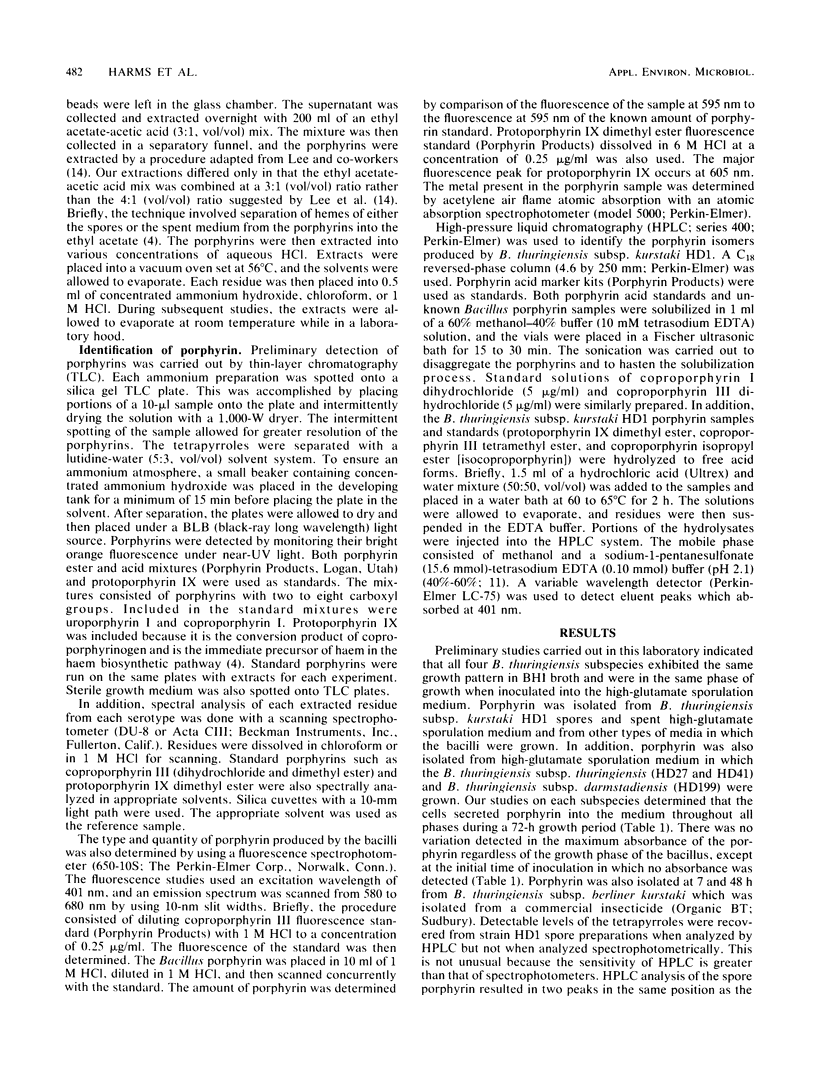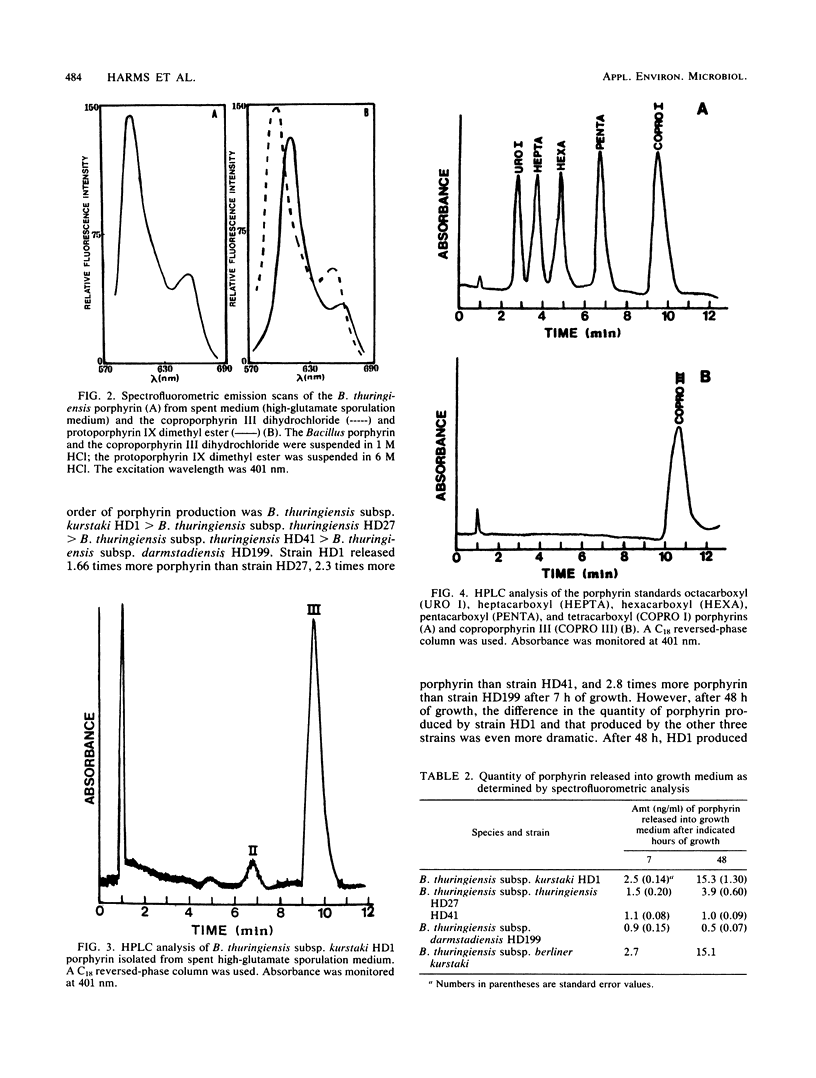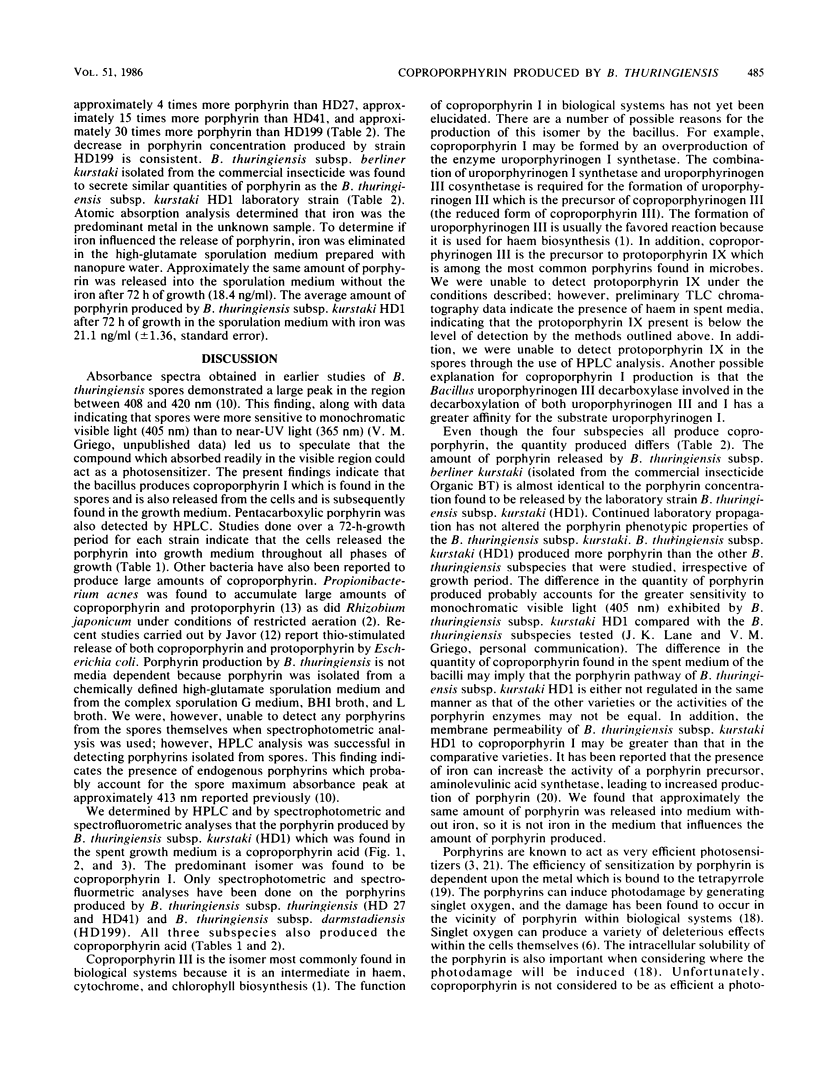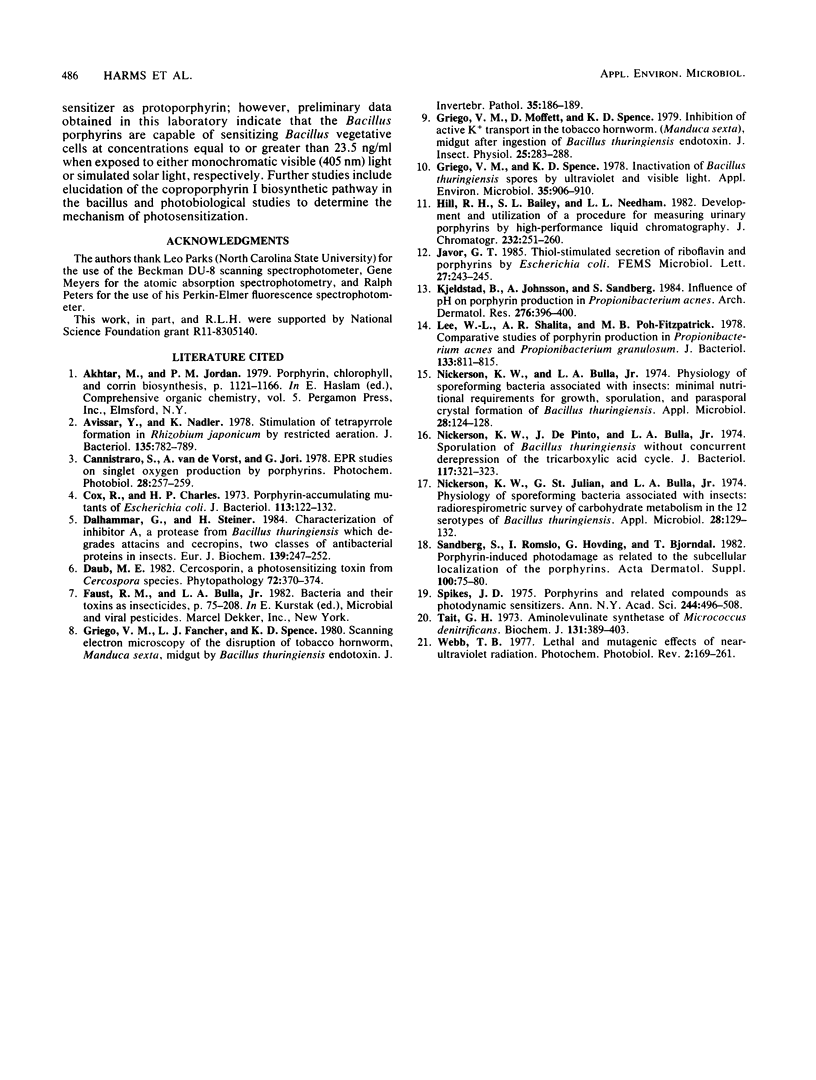Abstract
It was found by using spectrophotometric, spectrofluorometric, and high-pressure liquid chromatography that four subspecies of Bacillus thuringiensis produce coproporphyrin. The porphyrin isomer was identified as coproporphyrin I for B. thuringiensis subsp. kurstaki (HD1). The porphyrin was isolated both from spores and from a variety of spent growth media. The quantity of porphyrin released by each Bacillus subspecies differed. The rank order of porphyrin production follows: B. thuringiensis subsp. kurstaki HD1 > B. thuringiensis subsp. thuringiensis HD27 > B. thuringiensis subsp. thuringiensis HD41 > B. thuringiensis subsp. darmstadiensis HD199.
Full text
PDF





Selected References
These references are in PubMed. This may not be the complete list of references from this article.
- Avissar Y. J., Nadler K. D. Stimulation of tetrapyrrole formation in Rhizobium japonicum by restricted aeration. J Bacteriol. 1978 Sep;135(3):782–789. doi: 10.1128/jb.135.3.782-789.1978. [DOI] [PMC free article] [PubMed] [Google Scholar]
- Cox R., Charles H. P. Porphyrin-accumulating mutants of Escherichia coli. J Bacteriol. 1973 Jan;113(1):122–132. doi: 10.1128/jb.113.1.122-132.1973. [DOI] [PMC free article] [PubMed] [Google Scholar]
- Dalhammar G., Steiner H. Characterization of inhibitor A, a protease from Bacillus thuringiensis which degrades attacins and cecropins, two classes of antibacterial proteins in insects. Eur J Biochem. 1984 Mar 1;139(2):247–252. doi: 10.1111/j.1432-1033.1984.tb08000.x. [DOI] [PubMed] [Google Scholar]
- Griego V. M., Spence K. D. Inactivation of Bacillus thuringiensis spores by ultraviolet and visible light. Appl Environ Microbiol. 1978 May;35(5):906–910. doi: 10.1128/aem.35.5.906-910.1978. [DOI] [PMC free article] [PubMed] [Google Scholar]
- Hill R. H., Jr, Bailey S. L., Needham L. L. Development and utilization of a procedure for measuring urinary porphyrins by high-performance liquid chromatography. J Chromatogr. 1982 Nov 12;232(2):251–260. doi: 10.1016/s0378-4347(00)84165-1. [DOI] [PubMed] [Google Scholar]
- Kjeldstad B., Johnsson A., Sandberg S. Influence of pH on porphyrin production in Propionibacterium acnes. Arch Dermatol Res. 1984;276(6):396–400. doi: 10.1007/BF00413361. [DOI] [PubMed] [Google Scholar]
- Lee W. L., Shalita A. R., Poh-Fitzpatrick M. B. Comparative studies of porphyrin production in Propionibacterium acnes and Propionibacterium granulosum. J Bacteriol. 1978 Feb;133(2):811–815. doi: 10.1128/jb.133.2.811-815.1978. [DOI] [PMC free article] [PubMed] [Google Scholar]
- Nickerson K. W., Bulla L. A., Jr Physiology of sporeforming bacteria associated with insects: minimal nutritional requirements for growth, sporulation, and parasporal crystal formation of Bacillus thuringiensis. Appl Microbiol. 1974 Jul;28(1):124–128. doi: 10.1128/am.28.1.124-128.1974. [DOI] [PMC free article] [PubMed] [Google Scholar]
- Nickerson K. W., De Pinto J., Bulla L. A., Jr Sporulation of Bacillus thuringiensis without concurrent derepression of the tricarboxylic acid cycle. J Bacteriol. 1974 Jan;117(1):321–323. doi: 10.1128/jb.117.1.321-323.1974. [DOI] [PMC free article] [PubMed] [Google Scholar]
- Nickerson K. W., St Julian G., Bulla L. A., Jr Physiology of sporeforming bacteria associated with insects: radiorespirometric survey of carbohydrate metabolism in the 12 serotypes of Bacillus thuringiensis. Appl Microbiol. 1974 Jul;28(1):129–132. doi: 10.1128/am.28.1.129-132.1974. [DOI] [PMC free article] [PubMed] [Google Scholar]
- Sandberg S., Romslo I., Høvding G., Bjørndal T. Porphyrin-induced photodamage as related to the subcellular localization of the porphyrins. Acta Derm Venereol Suppl (Stockh) 1982;100:75–80. [PubMed] [Google Scholar]
- Spikes J. D. Porphyrins and related compounds as photodynamic sensitizers. Ann N Y Acad Sci. 1975 Apr 15;244:496–508. doi: 10.1111/j.1749-6632.1975.tb41550.x. [DOI] [PubMed] [Google Scholar]
- Tait G. H. Aminolaevulinate synthetase of Micrococcus denitrificans. Purification and properties of the enzyme, and the effect of growth conditions on the enzyme activity in cells. Biochem J. 1973 Feb;131(2):389–403. doi: 10.1042/bj1310389. [DOI] [PMC free article] [PubMed] [Google Scholar]


